Last updated: August 15, 2022
Article
The Legacy of General John Henry Hobart Ward
Preserving the artifacts of one of Gettysburg’s career soldiers
Rising from the enlisted ranks to that of a general officer is a significant accomplishment, especially to that of General John Henry Hobart Ward (1823-1903). Born to a prominent New York military family, Ward enlisted in the 7th U.S. Infantry at the age of 18 and eventually reached the rank of Sergeant Major. He saw action in the Mexican-American War where he suffered from wounds at the Battle of Monterrey in 1846. Following the conflict, Ward returned to New York where he eventually became the Commissary General of the state militia.
When the Civil War erupted, Ward recruited the 38th New York Infantry Regiment and served as its first commander at the rank of Colonel. He participated in all the battles and campaigns of the Army of the Potomac in the first two years of the war. He was promoted to brigadier general on October 4, 1862 and commanded a brigade at both Fredericksburg and Chancellorsville. At Gettysburg, his brigade took positions from Devil’s Den to the Peach Orchard on the morning of July 2nd. and participated in the ferocious fighting that accompanied the Confederate attack on the Army of the Potomac’s left flank later that day. The wounding of Major General Daniel Sickles elevated Ward to temporary division command. Following Gettysburg, Ward commanded a brigade in the reorganized Union Second Army Corps and participated in the Overland Campaign. Winfield Scott Hancock temporarily relieved him of command during the Battle of the Wilderness for “misbehavior and intoxication.” Ward mustered out of service July 18, 1864 with an honorable discharge. Unfortunately, he died tragically on July 24, 1903 after being struck by a train.
Ward left behind not only a written record of his military accomplishment, but also a physical record in the form of uniforms, weapons, and accoutrements that are now part of the artifact collection at Gettysburg National Military Park. Recently, thanks to the generous assistance of the Artist Preservation Group, some of those important historical artifacts have gone through professional conservation treatment at the National Park Service’s conservation labs in Charles Town, West Virginia. The conservation of these artifacts will ensure they are preserved for future generations to enjoy through research and exhibit in its Museum and Visitor Center.
So, what exactly did it take to conserve these historical artifacts? To answer that, we’ll take a look at the three Hobart Ward leather artifacts recently conserved by National Park Service objects conservator Fran Ritchie.
Hobart Ward’s Holster
Hobart Ward’s leather holster for a Smith and Wesson Model No. 2 Army revolver is constructed out of one piece of leather that is sewn along the edges to create the pocket for holding the weapon, plus a triangular flap to enclose the holster. A copper alloy button with eagle insignia (a uniform cuff button) secures the holster flap. There is a belt strap loop sewn onto the back of the holster. When donated, the leather was pliable and the object structurally sound, but there were tears in the leather on the top and bottom of the belt strap loop, and on the side under the strap/near belt strap – all a result of repeated use. The leather surface had shallow abrasions from use and age, and tiny fragments (most likely loosened pieces of pile from the flesh side/interior) could be visibly seen coming from the holster. Throughout the surface there were dull patches, dark patches, mottled surface on the flesh side from use. There was a waxy green copper stearate on the button that has also transferred onto leather flap.
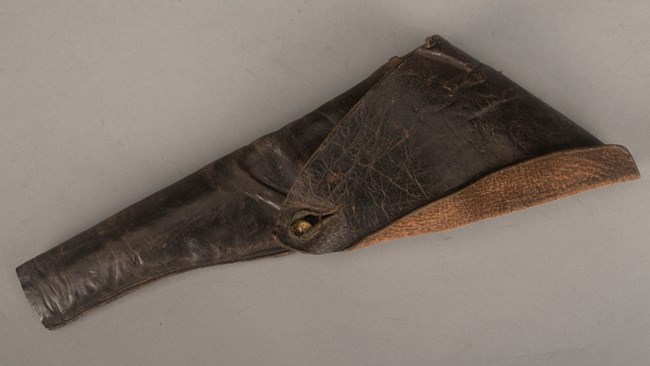
NPS Photo
The conservation treatment of the holster consisted of the following steps:
- Surface cleaning with brush and vacuum to remove any dust accumulation that may have occurred.
- Reducing copper stearate corrosion on the brass button and leather mechanically using a wooden skewer.
- Cleaning the button using cotton swabs dampened with mineral spirits, then coating using Agateen #27 in lacquer thinner (1:1) with UV marker C6. This coating helps prevent future copper stearate growth. The addition of the UV marker C6 allows for examination of the coating by fluorescing under Ultra-violet radiation.
- Stabilizing the ends of the tears in the leather to prevent them from propagating using Japanese tissue paper and acrylic emulsion mix Lascaux 498HV:360HV (3:1).
- Creating an internal custom support consisting of a carved piece of ethafoam covered in spun-bond polyester.
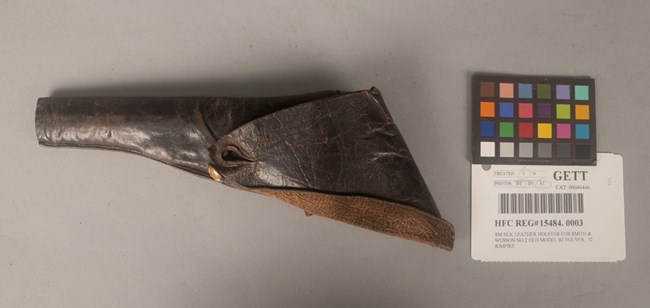
NPS Photo
The conservation treatment did not involve repairing or disguising the hole along the vertical side of the holster where the revolver’s hammer rested. This damage appeared old (the leather on the tear edges was worn), indicating that it could be from the active usage of the holster and was therefore a part of its history. The age of this damage was such that it could have been appropriate to its Civil War use.
Hobart Ward’s Boots
Hobart Ward’s boots are of dark brown vegetable tanned leather with stiff leather soles and 3 centimeter-high heels. There is a minimalist embroidered design on the shaft of each boot – a curvilinear “plant” that extends across the front with clusters of three “leaves” on each side - as well as a single star on the left and right sides. Each boot has a lighter color leather lining the top flaps and woven pull straps. When donated, the leather was still pliable and structurally sound. There were wear marks from use, including uneven heels, green rub marks around the heels from brass plated iron spurs, and lighter colored scuff marks from abrasion of the leather surface around the toes and heels. There were lighter colored micro cracks throughout the boots (also a sign of age), but the surface of the boots were not flaking. The creases in the toe areas had a “cloudy” appearance from dust accumulation. Ward or his descendants stored the boots flat with no internal support over a longer period of time, resulting in creases on the top flaps and greater wear areas bordering these creases.
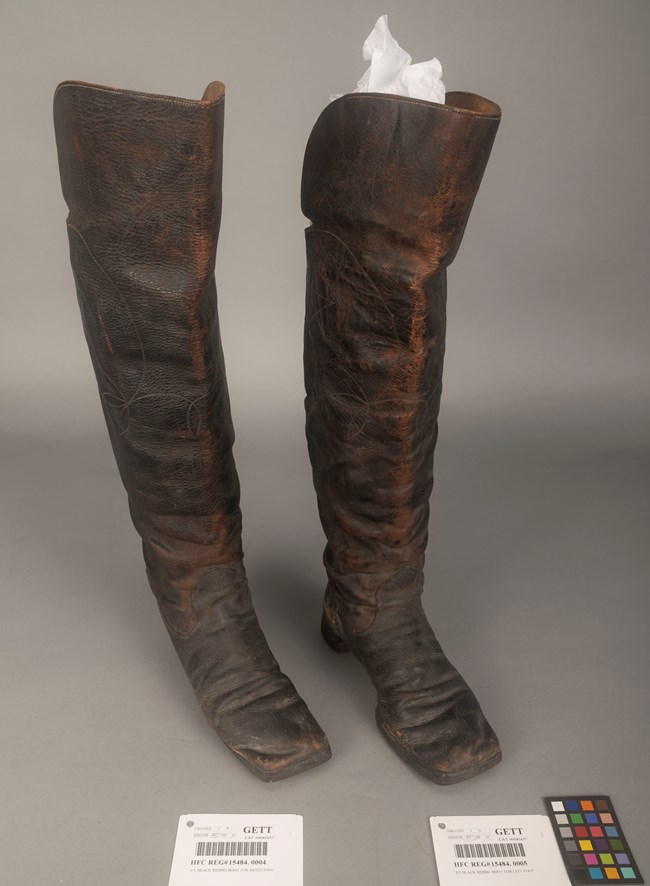
NPS Photo
The conservation treatment of the boots consisted of the following steps:
- Surface cleaning to reduce dust accumulation using dry methods (vacuum, brush, and sponges), and slightly water-dampened cotton swabs.
- Toning the leather loss in the creases along the front of the shaft using watercolor paint (as these were the result of storage and not original use).
- Adding black display fabric to the top of the boot inserts and also covering them with conservation-safe Tyvek fabric. These supports help the boots maintain shape and prevent any further leather loss on the creases.
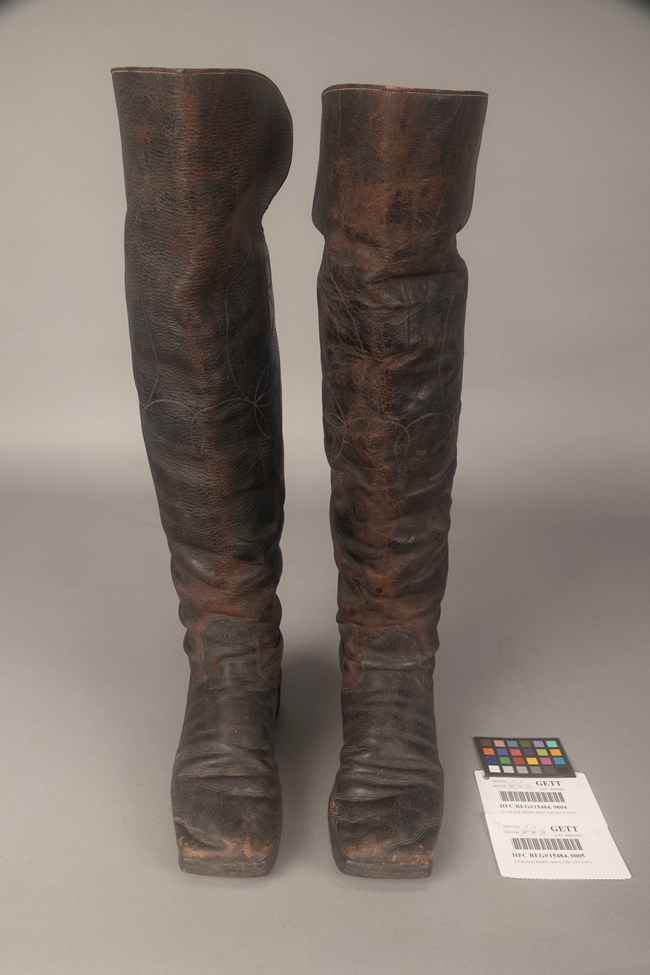
NPS Photo
As with the holster, conservation treatment did not involve repairing or disguising what appeared to be Civil War period wear on the boots. The loss of surface material on the front crease of each boot, however, was more recent (as the exposed leather was too bright) – leading to the decision to repair through watercolor paint toning.
Hobart Ward’s Spurs
Ward’s spurs are made of brass plated iron with a metal chain for under the heel. They have vegetable tanned leather straps that buckle to secure the spurs. The leather straps attach to the spur with a decorative rivet incised to resemble a flower. When donated, both spurs were structurally unstable because of the deterioration of their leather components. The dark top surface of the leather was worn on the edges of the straps and showed active flaking.
In addition, there were specific leather issues for each spur. The leather on one spur was detached near the metal rivet and was crudely repaired (at an unknown date) using brown thread. Although this repair prevented the leather from being lost completely, it risked compromising the condition of the leather in the long-term. There was also a tear in the leather strap that was in the buckle clasp. On the other spur, one side of the leather strap was detached near the metal rivet and was also crudely repaired (at an unknown date) using brown thread. The degradation of the leather caused it to tear from the stitches over time as it was handled. The larger piece of leather that is positioned under the buckle when the spur is in use was also detached because of the failure of the two leather loops that hold this piece in place. The top of each loop was torn away from the substrate. The brass plating on the metal portions was slightly worn around the interior heel portion from use. There was also a thin layer of green copper corrosion between the chain links.

NPS Photo
The conservation treatment of the spurs involved the following steps:
- Stabilizing the top layer of the leather (the black coating) to slow flaking and prevent further loss, using methylcellulose in deionized water and cellugel in ethanol.
- Removing thread from previous leather strap repair on both spurs.
- Stabilizing and repairing the torn leather straps on both spurs using acrylic adhesive mix Lascaux 498HV:360HV (3:1) and lining material of Japanese tissue paper. The adhesive and lining were applied using a heat spatula.
- Toning the lining to blend with surrounding leather using watercolor paint.
- Toning areas of loss of the black coating using watercolor pencil.
- Cleaning chain components to reduce copper corrosion using cotton swabs dampened with mineral spirits.
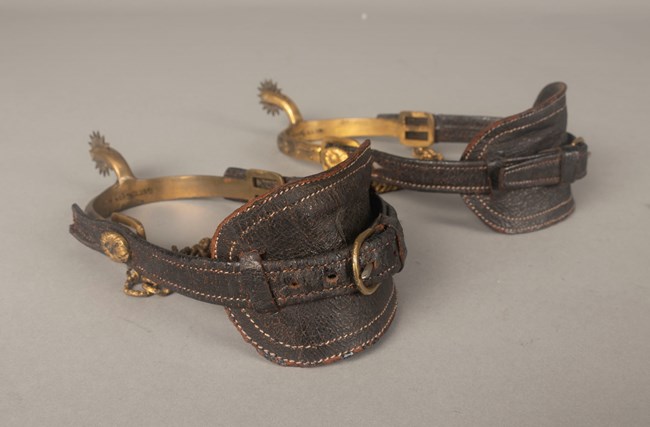
NPS Photo
As with the holster and the boots, conservation treatment did not involve repairing or disguising what appeared to be Civil War period wear. The conservator toned in exposed leather that was both bright and obvious – signs of more recent damage. The conservator also did not coat the metal components with a corrosion inhibitor, as 1) the corrosion was very minimal; 2) the spurs will be stored in an environmentally-controlled space when not exhibited; and 3) doing so would have required further manipulation of the leather that could have caused damage.Thanks to the generous support of the members of the Artist Preservation Group, these artifacts from Hobart Ward will be preserved, protected, and made safe for exhibition. By helping with this endeavor, APG has contributed to the efforts of the National Park Service to share the unique and critical stories of those who fought at Gettysburg and beyond.
